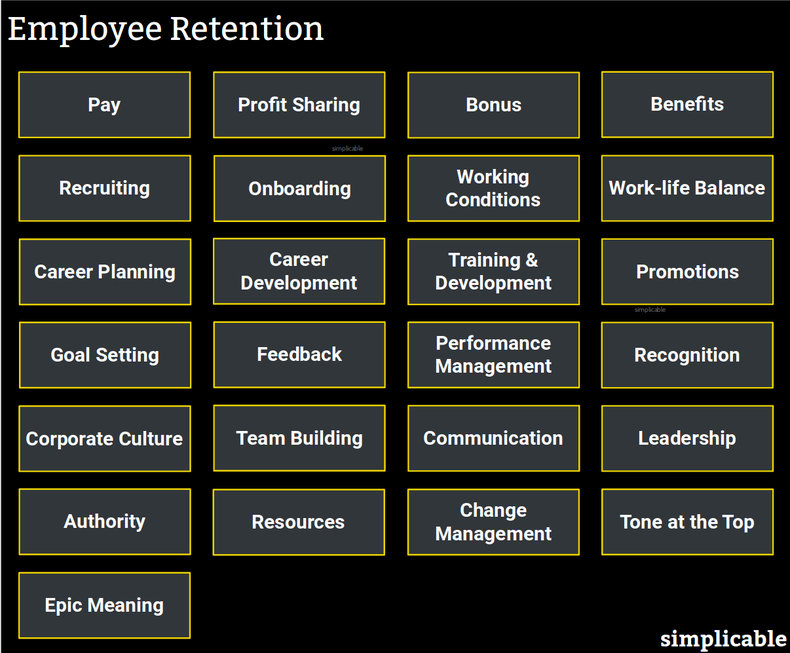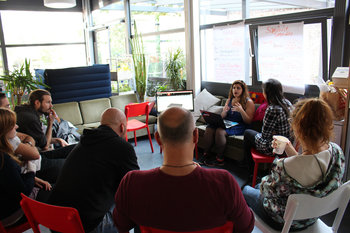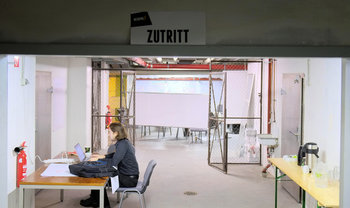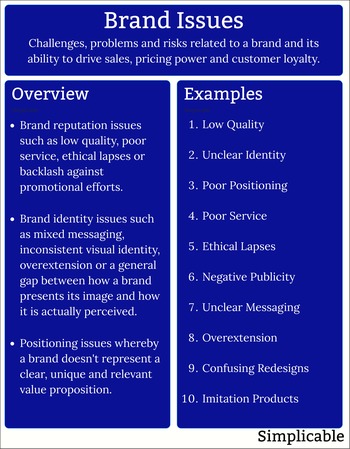
Pay
Employees are less likely to leave if their pay is above the market salary for their skills and are more likely to leave if their pay is below market.Profit Sharing
Compensation that increases the longer you stay with a firm such as a profit sharing plan that vests over time.Bonus
An annual bonus can improve employee retention as it gives employees incentive not to leave mid-year to year-end. This can be timed to discourage employees from leaving during a critical business season. For example, retailers who time their bonus for January after the Christmas season.Benefits
Benefits that are unique, generous or unusually valuable to an individual. For example, an employee who has their children enrolled in a high quality preschool sponsored by your firm may place high value on this benefit and view leaving as disruptive to their quality of life. Benefits can also be designed such that they increase as an employee stays with a firm longer.Recruiting
Losing new employees wastes your time and resources. As such, taking care to recruit employees who are a good fit for a role and seem dependable is a fundamental basis for improving employee retention. Setting expectations about the nature and demands of a role also reduces turnover.Onboarding
Onboarding is the process of giving employees everything they need to do their job from the moment they start. This includes resources, information, introductions and socialization. A new employee who is left isolated without proper resources and support can quickly become disillusioned.Working Conditions
Working conditions such as the comfort of an office, working hours or travel requirements of a role.Work-life Balance
Employees commonly exit to improve their quality of life. As such, reasonable hours and flexibilities that help an employee to balance multiple demands on their time can improve employee retention.Career Planning
Asking employees about their goals for their career.Career Development
Providing employees with a path to achieve career goals by providing support such as mentorship, training and opportunities to take on challenging work.Training & Development
Training and development programs related to company needs or the career plans of individuals can provide a sense of growth that is conductive to employee retention.Promotions
Promoting from within help to motivate your employees and hiring from the outside to fill coveted positions can be demotivating. As such, programs and policies that give employees fair consideration for job openings improves employee retention.Goal Setting
Setting expectations with employees by regularly agreeing to a set of performance objectives with each employee.Feedback
Regularly providing feedback to employees to recognize high performance and to give employees plenty of time to correct low performance.Performance Management
Providing formal performance reviews. High performers, who are the focus of employee retention efforts, may view performance management as important formal recognition and documentation of their performance.Recognition
Employees are often motivated by a desire for respect from their peers. As such, formal and informal recognition of accomplishments in a group setting can improve employee satisfaction and reduce turnover.Corporate Culture
Establishing productive norms and shared meaning. For example, norms of politeness such as the expectation that employees address each other respectfully.Team Building
Providing teams with opportunities to break out of their routines and socialize.Communication
Sharing information with employees and giving them a voice in strategy and decisions.Leadership
Leadership is the practice of motivating people to get them moving in the same direction with common purpose. Poor leadership is the root cause of a great deal of avoidable turnover.Authority
Providing employees with the authority they require to be productive. An employee who lacks the authority to do their job well is likely to be unhappy. For example, a customer service agent who is unable to issue a refund when a customer clearly deserves one.Resources
Employees who struggle with inefficient or lacking resources are likely to be unhappy. For example, a designer who could get 50% more done if their software wasn't so unusable.Change Management
Employees may value stability and be uncomfortable with rapid change. In fact, employees may actively resist change. Change management is the leadership practice of engaging employees in change to gain acceptance of it.Tone at the Top
Tone at the top is the behavior and competence of a firm's executive management. Employees who believe they are led by admirable and competent individuals are more likely to be motivated.Epic Meaning
Epic meaning is a sense that you are part of something that is changing the world in a significant and positive way. This can be extremely motivating and is the basis of employee loyalty. An employee who believes a firm is probably making the world a more unpleasant place is unlikely to feel a sense of intrinsic motivation. An employee who believes your mission is urgent, important and inspiring is less likely to leave.| Overview: Employee Retention | ||
Type | ||
Definition | The ability of a firm to prevent talent from leaving. | |
Related Concepts | ||
































